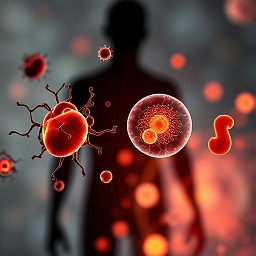 Aging is not merely the passage of time, but a fundamental biological process characterized by the gradual decline of cellular and tissue function. Central to this deterioration is the accumulation of aged, non-dividing cells known as senescent cells. These cells, eventually become detrimental, secreting inflammatory molecules that drive chronic disease and tissue dysfunction. The field of regenerative medicine has identified a revolutionary approach to combat this cellular decay: the conversion of these aging somatic cells into induced pluripotent stem cells (iPSCs), effectively “resetting” their biological clock.
Aging is not merely the passage of time, but a fundamental biological process characterized by the gradual decline of cellular and tissue function. Central to this deterioration is the accumulation of aged, non-dividing cells known as senescent cells. These cells, eventually become detrimental, secreting inflammatory molecules that drive chronic disease and tissue dysfunction. The field of regenerative medicine has identified a revolutionary approach to combat this cellular decay: the conversion of these aging somatic cells into induced pluripotent stem cells (iPSCs), effectively “resetting” their biological clock.
This technique, initially pioneered by Dr. Shinya Yamanaka, involves introducing four specific transcription factors—Oct4, Sox2, Klf4, and c-Myc (collectively known as OSKM, or Yamanaka factors)—that erase the cell’s acquired identity and chronological age [2]. This process offers a profound opportunity to reverse cellular aging, potentially providing a path to widespread health extension. This essay argues that cellular reprogramming, particularly through the controlled, transient application of factors that reverse the biological age of senescent cells, represents a paradigm-shifting strategy capable of neutralizing the core drivers of aging, thereby revolutionizing both regenerative medicine and therapeutic longevity.
The Imperative of Cellular Reprogramming
 The concept of cellular rejuvenation transcends mere anti-aging cosmetics; it addresses the underlying mechanisms that limit human healthspan. The importance of pursuing this line of research is underscored by three critical elements: the direct elimination of the senescent burden, the promise of patient-specific regenerative tissues, and the ability to reset the epigenetic clock without loss of cell identity.
The concept of cellular rejuvenation transcends mere anti-aging cosmetics; it addresses the underlying mechanisms that limit human healthspan. The importance of pursuing this line of research is underscored by three critical elements: the direct elimination of the senescent burden, the promise of patient-specific regenerative tissues, and the ability to reset the epigenetic clock without loss of cell identity.
1. Directly Neutralizing the Senescent Cell Burden
Cellular senescence is now firmly established as one of the nine canonical hallmarks of aging. As we age, senescent cells accumulate in nearly all tissues, from the brain and lungs to the joints and vasculature [3]. Although they cease dividing, these cells remain metabolically active and acquire the Senescence-Associated Secretory Phenotype (SASP). The SASP is a cocktail of highly inflammatory proteins, including interleukins and chemokines, which disrupts the local tissue microenvironment, impairs stem cell niches, and triggers a state of chronic, low-grade systemic inflammation [4]. This inflammation is the engine that drives nearly all age-related chronic diseases, including cardiovascular disease, type 2 diabetes, neurodegeneration, and osteoarthritis [3].
By converting an aged or senescent cell into a nascent, youthful stem cell, the reprogramming process does not simply remove the senescent cell (as senolytic drugs attempt to do); it fundamentally rewrites the cell’s fate, eliminating the SASP and resetting the cellular machinery. This comprehensive erasure of aging characteristics offers a more complete therapeutic intervention, moving beyond damage control to full rejuvenation.
2. The Unprecedented Potential for Autologous Regenerative Medicine
The second compelling reason to advance this technology lies in its utility for generating replacement tissues and organs tailored perfectly to the individual patient. When a senescent skin cell from a patient is fully reprogrammed into an iPSC, this new stem cell is genetically identical to the patient’s other cells. These iPSCs can then be coaxed, or differentiated, into any other cell type required—such as functional cardiomyocytes (heart muscle cells), pancreatic -cells, or dopaminergic neurons [5].
This capability solves two monumental problems in traditional transplantation and regenerative medicine: tissue shortage and immune rejection. If a patient requires new cardiac tissue to repair heart damage, the newly grown cells, derived from their own body, are autologous. This means they will not be recognized as foreign by the immune system, eliminating the need for lifelong, debilitating immunosuppressive drugs that carry significant health risks. This potential for personalized, rejection-free therapy opens the door to repairing complex age-related tissue damage with unprecedented safety and efficacy.
3. Resetting the Epigenetic Clock via Partial Reprogramming
 While the conversion to iPSCs is powerful, it is associated with a risk: the potential for uncontrolled growth and tumor formation (teratomas) if the process is incomplete or sustained in vivo [6]. The focus of recent research has therefore shifted to partial cellular reprogramming. This refined technique involves transiently exposing aged cells to the Yamanaka factors, stopping the process before the cell completely loses its somatic identity and becomes fully pluripotent.
While the conversion to iPSCs is powerful, it is associated with a risk: the potential for uncontrolled growth and tumor formation (teratomas) if the process is incomplete or sustained in vivo [6]. The focus of recent research has therefore shifted to partial cellular reprogramming. This refined technique involves transiently exposing aged cells to the Yamanaka factors, stopping the process before the cell completely loses its somatic identity and becomes fully pluripotent.
The goal of partial reprogramming is not to create a stem cell, but simply to "dial back" the cell's age. This age is quantified using epigenetic clocks, which measure DNA methylation patterns at specific sites across the genome to determine a cell’s true biological age [7]. Studies have shown that a brief, cyclic exposure to the reprogramming factors can successfully reverse these epigenetic markers, making a cell appear decades younger on the clock, without inducing the dangerous state of full pluripotency. This demonstration—that aging can be reversed by manipulating epigenetic information rather than genetic content—provides a safer, more translatable strategy for systemic rejuvenation, potentially treating entire organisms without complex cell harvesting or transplantation procedures.
Conclusion
The ability to convert aging cells into a more youthful, regenerative state represents a monumental scientific leap, offering viable solutions to the pervasive issues of cellular senescence, tissue failure, and the chronic diseases they accelerate. By confronting senescence, enabling autologous tissue repair, and demonstrating a capacity to safely reset the body’s biological timers through partial reprogramming, this field stands poised to fundamentally alter the human experience of aging.
However, moving this technology from the lab bench to clinical reality requires concerted effort. Researchers must continue to refine the safety profiles of partial reprogramming, particularly by identifying non-genetic, chemical-only alternatives to the OSKM factors, which have shown promising results in initial studies [8]. Furthermore, governments and private foundations must prioritize sustained funding for translational research in this area. We have moved past the theoretical; the science is now demanding robust development. But one question remains, what happens to the planet's ability to sustain life if we dramatically extend lifespan without placing global limits on reproduction?
References
- López-Otín, C., Blasco, M. A., Partridge, L., Serrano, M., & Kroemer, G. (2013). The hallmarks of aging. Cell, 153(6), 1194–1215.
- Takahashi, K., & Yamanaka, S. (2006). Induction of pluripotent stem cells from mouse embryonic and adult fibroblast cultures by defined factors. Cell, 126(4), 663–676.
- Gorgoulis, V., Adams, P. D., Alimonti, E., Christofidou-Solomidou, D., Douw, H., Feig, V. R., ... & Zantl, P. (2019). Cellular senescence: defined and interrogated by complex landscapes of pathophysiology. Nature Reviews Cancer, 19(11), 609-624.
- Krizhanovsky, V., & Häfeli, M. (2020). Senescence and the Senescence-Associated Secretory Phenotype (SASP). The Biology of Aging.
- Didié, M., Christalla, P., Wagh, L. S., Fuchtbauer, A. C., Fuchtbauer, E. M., Werner, N., ... & Kögler, G. (2013). Successful generation of functional cardiomyocytes from human induced pluripotent stem cells (iPSCs). Molecular Therapy, 21(3), 670–677.
- Ocampo, A., Reddy, P., Martinez-Redondo, P., Borodkina, I., D’Adesky, K., & Krizhanovsky, V. (2016). In vivo amelioration of age-associated hallmarks by partial reprogramming. Cell, 167(7), 1719-1733.e12.
- Horvath, S. (2013). DNA methylation age of human tissues and cell types. Genome Biology, 14(10), R115.
- Liu, T., Zhang, S., He, M., Zhu, R., Zhu, J., Geng, J., ... & Deng, H. (2020). Transient expression of OSK factors for cellular rejuvenation and tissue repair. Science Advances, 6(31), eaba3553.






